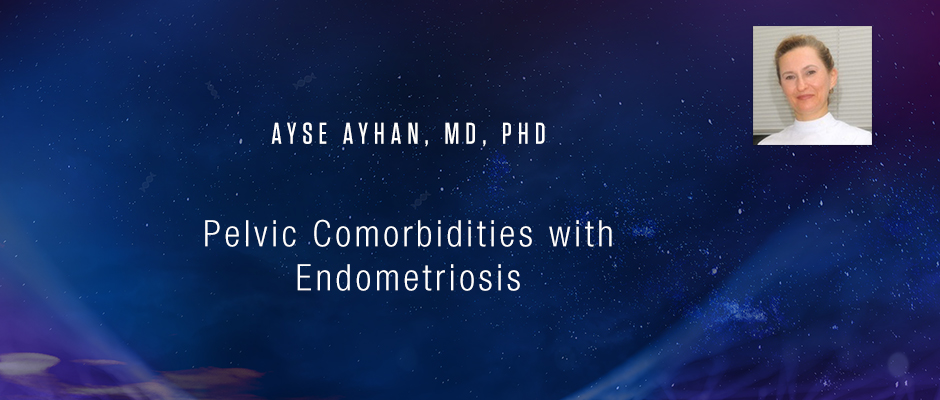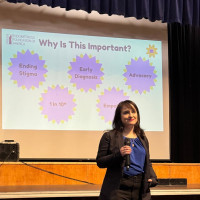Ayse Ayhan, MD, PhD - Pelvic Comorbidities with Endometriosis
Endometriosis Foundation of America
Medical Conference 2019
Targeting Inflammation:
From Biomarkers to Precision Surgery
March 8-9, 2019 - Lenox Hill Hospital, NYC
https://www.endofound.org/medicalconference/2019
Thank you for introducing. It's a privilege for me to be among endometriosis giants, and I'm grateful to my 50 year long friend, my classmate Dr. Seckin, and his family, and also the foundation to make me here with you.
And I thank you all, all the speakers, all the wonderful speakers, and the contributors to join to enlighten the unknowns in endometriosis. I will start from the topic. There are lots of comorbidities and lots of epidemiological studies which search a kind of relation, or association with endometriosis. It is a disabling disease for many years, and it's impossible to talk all about them.
And furthermore, many of them are like starting from infertility to cystitis to... which one to show? Okay. Like from constipation, depression, mood disorders, myalgia. So many different diseases.
It's well-known that it's a systemic disease. There are lots of systemic effects. It's a very complicated disease; however, once it was known as a focal disease, and to me, as a pathologist, I'm more involved in pelvic disorders. That's why I selected the pelvic comorbidities associated with endometriosis, so that I will be able to share more information with you.
I will follow this navigation. First I will try to talk about the uterine problems other than cancers, like uterine mullerian abnormalities and endometrial polyps. I will now talk about the following too: lesions, though they are very common. And also, I will talk about some pelvic cancers and our own experience with endometriosis related pelvic cancers.
If it starts from uterine or mullerian abnormalities, the mullerian system and endometriosis is a disorder of mullerian system. And normally uterine abnormality is seen up to 6% in unselected population, if searched like 100,000 unselected population. I believe that disease is more common, because even in the hands of pathologists or general gynecologists, most of the mullerian abnormalities or subtle abnormalities are not well-diagnosed.
In 2015, in Journal of Minimally Invasive Gynecology, a group from Italy, which is an infertility center. Evaluation of septic uterus, any kind of septation, subtle to bigger non obstructive septation was found to be 33% over all among 343 patients. Among them 37% of patients were with endometriosis, versus 27% of the patients with this abnormality developed endometriosis and the difference was certainly significant.
Nevermind, apparently there is a bias, because this is an infertility clinic, not an endometriosis clinic. Most of the patients, the symptoms they say, I don't know if endometriosis is a symptom, but they showed that most patients who came saying that they have endometriosis, were found to have an abnormal uterine cavity. However, endometriosis stage they don't have any relation with the presence of septation.
Now I'm with the permission of Dr Seckin, I want to present you his results in the book of hysteroscopy. He examined 260 patient, 160 with normal cavity, and 100 with arcuate cavity. More than 1/3 of patients had arcuate uterus, than they come to endometriosis clinic. Total number of endometrioma in the patients with hysteroscopically arcuate cavity, were significantly higher compared to the hysteroscopically normal uterine cavity. Furthermore, laparoscopies usually see more lesions to biopsy, than there is arcuate cavity. That means the number of lesions are more to biopsy.
Next I will talk about endometrial polyps. Two of them are here, along with the endocervical polyp here. They may be associated with endocervical polyps, usually polyp is described as a localized hyperplastic growth of endometrial glands and stroma. To me it is hamartoma, usually glands are not proliferated, there's no proliferation in the glands but the stroma is more prominent. 25% of the population may have this lesion, especially infertile women, have more common endometrial polyps; As far as some hormonal alterations, or biochemical levels of the biomarkers are similar.
There is an expected causal relationship between endometrial polyps and endometriosis. This is how Dr Seckin sees endometrial polyp, in an endometriosis patient, and this is how we observe under the microscope. But to tell the truth, if you biopsy this lesion, of his biopsy. Most of the pathologists will not reply you that there is a biopsy. Its quite difficult if you don't deal with gynecopathologists, or if you don't have time, or if you're so busy you just say there is no malignancy, no hyperplasia.
The reason of endometrial polyp, the endo-pathogenic reason of endometrial polyp and endometriosis are not known, but they have some common [inaudible 00:10:17]. There maybe a cause relationship which was written in 2003. It is expected to have a relation between endometrial polyp and endometriosis, If you diagnose with endoscopy, hysteroscopy, you find frequencies more.
If you take office biopsy or DNC, whatever, don't expect your pathologist tell you 100% correct response if the polyp is not big. This is a big polyp, you see the parallel glands and the stroma, even though, if you show this to a pathologist, someone may say this is a normal endometrium. The people want to see the whole polypoid architecture. There are some morphologic clues for us, for example, abnormal vascularity, or abnormal stromal spindling, or appearance; I should say, and glandular distortion.
Normally in secondary phase we have these vessels so I don't advise to take office biopsy, to my colleagues. When the patient is in secondary phase, if he wants me to diagnose endometrial polyp, because functional polyps may not show their real faces. So there's another one, there is no glandular alteration other than, a kind of cystic change, and you cannot see any vascular change, but we have the spindling which I prefer to write; Polyp is expected, due to the stromal alteration. So hystopathologically also the biopsy diagnosis of polyp is not always the best.
In 2015 there is a report comparing endometrial polyps and endometriosis, this is a meta-analysis. [inaudible 00:13:33] Control and case-control studies were included. They found a significant increase in risk of polyps in women with endometriosis, compared with those without endometriosis. With relative risk ratio around 3. Different from the previous study they found slightly increased endometriosis, slightly increased frequence of polyp in stage 1 endometriosis patients.
If we go to the infertility clinics, as I mentioned for previous slide, the frequency goes up, there's higher prevalence of endometrial polyps and usually those who come to infertility clinics, are more symptomatic. This is from the infertility clinic, there is a significant increased prevalence of endometrial polyp, compared to non endometriosis patients, and there is a difference between stage 1, to stage 2-4 patients.
Although you can see a big polyp here, and diagnosis a polyp. May there be any polyp associated lesion, or can you see this area? Its just below the polyp, and it is difficult to get it. If proper biopsy is not done, this is a precursor of endometrial cancer; endometrial intraepithelial neoplasia.
Some of you may wonder whether endometrial cancer is also frequent with endometriosis. So I will talk about endometrial cancers. The epidemiological studies, thanks to Dr.[Meismar] gave a lot of information about these diseases. This is again a nurse study the patients have 18 years follow up, and there's 100,000 patient, and they were not able to find a neural association of endometrial cancer and endometriosis; either self reported endometriosis or laparoscopically confirmed endometriosis, so endometrial cancer is not more common in endometriosis patients based on this study.
This is a very recent study, again a meta-analysis, there are 23 studies included, and 20 of them show a kind of slightly increased endometrial cancer in endometriosis patients. However, two studies show no relation so the main issue here, the statistical power is not enough as you can see, like the number of patients in every study like 50, 59 so very few, the statistical power is very low.
How about cervix cancer, so the risk of extraovarian malignancies among women with endometriosis, from the same study, 2019 study. As you can observe from this diagram, there seems to be a negative association between endometriosis, and uterine cervix cancer. However, even lower number of cases, told us the statistical power is so low, however none of these reports, including the HPV study of those patients also, all the studies with negative association, were mostly coming from Scandinavian countries.
Perhaps these patients are under the control of a gynecologist, and if there is an early legion, a precursor legion removed. Or, otherwise they may not have equal number of sexual relation with those cervix cancer. As far as it is an HPV related disease, so studies with HPV relation are necessary.
Although Dr. Broach mentioned in detail, I will briefly speak about, endometrium related ovarian neoplasia, just to share my experience. There is a hystopathological evidence that endometriosis related ovarian cancers namely, clear cell ovarian cancer, and endometrial type ovarian cancer, occur in endometriotic cysts. There is a well known epidemiological evidence in case control studies that endometrial and clear cell cancers are common among self reported endometriosis cancer patients. Dr.[Meismar] study show us that there should be a causal relationship between endometriosis and ovarian cancers, because studies suggest that endometriosis, should be a precursor to clear cell endometrial ovarian cancer.
We have transcript on profile evidence, and we have molecular genetic evidence, I will show you one of the molecular genetic evidence, where we published with Dr. Seckin again in 2012 before that, we also examined, PTEN, PIK3CA's mutations but then we checked ARID1A's mutations and compared an endometriotic cyst with the related clear cell and endometrial cancers, because of the exome's, and RNA sequences reported previously, understood that non-sense mutations, or loss of function mutations of ARID1A gene is 100% it continues endometriosis. Normally in endometriosis, we have ARID1A, and in normal endometrial tissue, and in all our normal tissues, this isn't proliferation suppressor, tumor suppressor gene. We do have ARID1A, however ARID1A gene, is lost in tumor. ARID1A gene is lost in the continues, endometriosis in 100% of patients. This alteration is found in 1/3 of endometrial and clear cell ovarian cancers.
We wanted to take another endometriosis related ovarian neoplasm named, Seromucinous borderline, and Seromucinous carcinoma. When we checked ARID1A, laws in this tumor, we also found that this is endometriosis related cancer, as we see under the microscope. From 2014, this tumor became a different entity, in W-H-O classification, now it is, endometrium related ovarian neoplasms. This comes from the diverse functions of ARID1A. It is related to; DNA damage repair, cancer metabolism, transition, and cell cycle, and of course, the Fenton Reaction, iron and DNA damage.
So finally, I would like to thank you for listening to me, and if we have time, I am waiting for your questions. And I thank you all.










